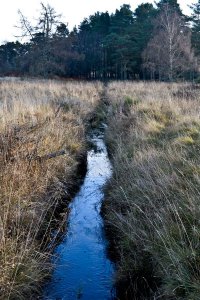IUCN/SSC Otter Specialist Group Bulletin

|
©IUCN/SCC Otter Specialist Group Volume 31 Issue 1 (January 2014) Citation: Kruuk, H. (2014). Sprainting Into The Wind. IUCN Otter Spec. Group Bull. 31 (1): 12 - 14 Hans Kruuk 1 1Formerly Centre for Ecology and Hydrology, Banchory, Scotland |

|
| Received 23rd November 2013, accepted 26th November 2013 |
| Abstract: Otters Lutra lutra deposited scent-marks (spraints) along a small stream in Scotland. The large majority of spraints was found on the bank upwind of the stream, whereas remains of frogs eaten by the otters were found on either bank, showing that otters used both banks equally, but wind-direction was a factor in selection of one bank for scent marks. |
| Keywords: otter; Lutra lutra; communication; frog predation |
| Française | Español |
INTRODUCTION
Otters (Lutra lutra) are probably unique amongst Carnivora in the number of defaecations (spraints) they regularly produce per day, more than 30 (Kruuk, 1992, 2006). This refers to the number of spraints one sees being deposited when watching the animals in the wild, but otters also often defaecate when swimming, bending the tail above the surface. An explanation for the high frequency of sprainting on land is the role spraints play as scent marks, apart from the obvious role of elimination of faeces.
The scent-marking role is evident when watching otters’ behaviour to spraints from other otters (approaching, sniffing, over-marking, etc.), and also from the conspicuousness of the locations where spraints are deposited. Such aspects of scent-marking with faeces are common amongst carnivores (Gorman and Trowbridge 1989). For instance, I noticed that spotted hyaenas (Crocuta crocuta), a species that habitually follows paths and roads in its range, defaecate in their latrines which are located significantly more often on the upwind side of tracks rather than downwind, in their windy, open habitat in the Chalby Desert in northern Kenya, where winds tend to come mostly from one direction (unpubl. obs.). This behaviour makes sense if faeces have a role in communication. The present paper investigates whether otters show comparable behaviour.
The opportunity to study the effect of wind-direction on sprainting behaviour presented itself in Scotland in an area where otters used a kilometers long, straight artificial stream in open country. Otters used the stream when travelling between a marsh and a small river, and they sprainted on its banks. Also, otters foraged for common frogs (Rana temporaria) in the stream, and when they caught a frog, climbed onto one of the banks to dismember and consume it. In order to study whether wind direction influenced the location of spraint sites, I compared on which side of the stream I found spraints, and remains of frogs.
STUDY AREA AND METHODS
Observations were made during 9 visits in January and February in 2007, 2008 and 2011. Observation sites were along 2km of the Gellan Burn (Ordinance Survey end-points NJ488021 to NJ506017), running from approx. WNW, 280° to ESE, 100°. It is straight with only two slight bends, rarely wider than 1m or deeper than 0.5m. In this area the prevailing wind direction is very predominantly SW, therefore the south bank of the stream is upwind, for any animal swimming. The banks are sloping, 1-2m high, exposed, covered in mostly grass or rushes, with very few trees, shrubs or other obstacles, through open, flat country. The vegetation on either side of the stream was similar (Fig. 1).
 |
| Figure 1. Study site at the Gellan Burn (click for larger version) |
Otters are quite frequently seen along the stream, males as well as females with or without cubs, but their numbers are unknown. They defaecated, sprainted, either on established sites were other spraints were or had been present, or more commonly just anywhere on the bank, near grass clumps, on stones or on small rises.
Common frogs are abundant and they winter in the bottom of the stream where otters catch them in winter or early spring, taking the prey up the bank to eat it. When an otter consumes a female frog during that season, it almost always leaves a conspicuous, quite large clump of white jelly, the remains of the frog’s egg clump. Occasionally other predators catch frogs here (grey heron Ardea cinerea, buzard Buteo buteo, fox Vulpes vulpes), but they either consume the frogs’ egg-jelly, or leave it a long way from the water (pers. obs.). I assume, therefore, that frog-jellies left along the stream are remains of otter prey.
During every visit all spraints and frog jellies were noted, whether south or north of the stream, and spraints and jellies were removed to prevent double-counting in subsequent visits.
RESULTS
There was a highly significant difference in the north-south distribution of spraints and jellies (Table 1): if an otter caught a frog, it would climb the bank on either side of the stream to eat it, but if it was about to deposit a spraint, it would climb the south bank five times more often than the north bank.
The south bank was upwind of the otter when it coursed along the stream, and there were no other obvious differences between the two banks in vegetation or other environmental variables.
DISCUSSION
The results suggested clearly that otters had no preference for either stream bank for feeding purposes, but significantly preferred the upwind bank for sprainting. It was not possible to investigate whether in this preference otters were reacting to previous spraints or spraint sites, or only to the wind direction, or to both, although to some extent this is immaterial. The results strongly suggest that, either in the past when spraint stations were established, or immediately preceding my observations, otters did take wind direction into account when sprainting. The finding confirms the importance of spraints in scent communication between individual otters; it also might have a practical use for research, when searching for spraints along river banks in open country.
REFERENCES
Gorman, M.L., Trowbridge B.J. (1989). The role of odor in the social lives of carnivores. In: Gittleman, J.G. (ed.) Carnivore behavior, ecology and evolution, pp. 57-88. Cornell University Press, Ithaca NY, U.S.A.
Kruuk, H. (1992). Scent marking by otters (Lutra lutra): signalling the use of resources. Behavioral Ecology, 3,133-140.
Kruuk H. (2006). Otters, ecology, behaviour and conservation. Oxford University Press, Oxford.
Résumé : Epreintes dans le Vent.
Les loutres Lutra lutra déposent leurs épreintes le long d’un petit cours d’eau en Ecosse. La majorité des épreintes sont trouvées sur la rive au vent du ruisseau, alors que les restants des grenouilles consommées par les loutres sont répartis sur les deux rives, montrant que les loutres utilisent également les deux rives dans ce cas, mais que le sens duvent influe sur le choix d’une rive pour déposer leurs épreintes.
Revenez au dessus
Resumen: Marcando en el Viento
Las nutrias Lutra lutra depositaron marcas olorosas (spraints) a lo largo de un pequeño arroyo en Escocia. La gran mayoría de spraints fue encontrada en la barranca contra el viento, mientras que los restos de ranas comidas por las nutrias fueron encontrados en ambas barrancas, mostrando que las nutrias usaron ambas barrancas igualmente, pero la dirección del viento fue un factor que influyó en la selección de una barranca para dejar las marcas olorosas.
Vuelva a la tapa